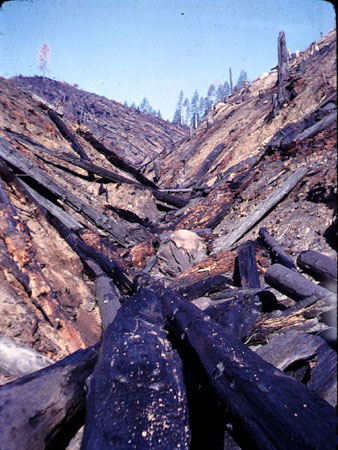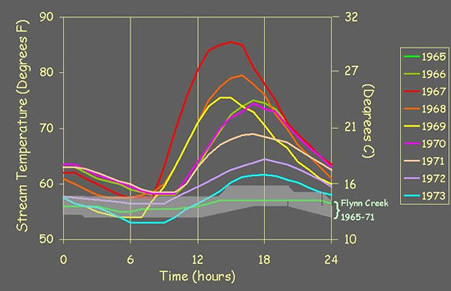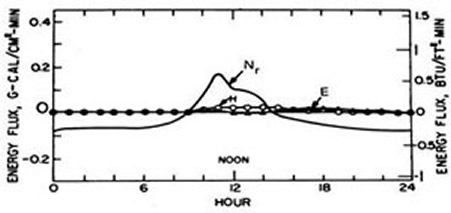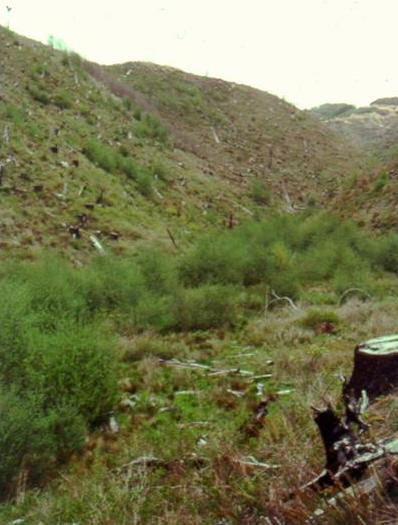Water Temperature
by George W. Brown, Dean Emeritus, Oregon State University
In the early 1960s, scientists speculated that one of the key impacts of timber harvesting using the clearcutting techniques of the day was increased water temperatures in streams draining forested watersheds. A network of thermographs was installed in the three Alsea Watershed study basins in March 1964 to test this hypothesis. Temperature was continuously monitored at the outlet of each watershed and at selected points within Needle Branch and Deer Creek.
Timber harvesting occurred in the summer of 1966. Narrow strips of trees, usually alder, separated the small clearcuts in Deer Creek from the stream channel. In Needle Branch, all riparian vegetation was purposely removed, exposing the entire length of the stream to direct solar radiation. The hot slash fire following logging on Needle Branch further insured no riparian vegetation remained for the first summer.
Figure 1. Upper reaches of Needle Branch after clearcutting without a riparian management area and then prescribed burning, which greatly increased exposure of the channel to direct solar radiation.

Large temperature increases were recorded immediately on Needle Branch. Maximum daily temperatures increased to 85°F, roughly 20°F above pre-harvest maxima (Figure 2). No changes in daily maxima or mean monthly maxima were noted on Deer Creek, even with very narrow strips of riparian vegetation (Brown and Krygier, 1970).
Figure 2. Streamwater temperature patterns on the day of annual maximum for Needle Branch (colored lines) and the range of data for Flynn Creek from 1965 to 1971 (based on a figure from Moring, 1975).

Energy balance studies were initiated on the study streams in 1965 and 1966 to quantify the sources of energy input. The predominant role of direct-beam solar radiation in controlling stream temperature was clearly established (Figure 3), with a much smaller role played by convection and evaporation (Brown, 1969). The predominance of direct-beam solar radiation led to the development of a mathematical model for predicting the impact of clearcutting on stream temperatures using this variable alone (Brown, 1970).
Figure 3. Energy flux for forested (a) and nonforested (b) streams from figures by Brown (1980) and based on Brown (1969) showing net thermal radiation (Nr), evaporation (E), and convection (H).

Further confirming the role of direct-beam solar radiation on the extraordinary increases in temperature observed for Needle Branch is the pattern of temperature recovery observed. While upslope reforestation in Needle Branch initially involved seeding and was slow by today’s standards, recovery of riparian vegetation, particularly alder, was rapid and provided blocking shade for the stream (Figure 4). This rapid recovery of the riparian vegetation resulted in equally rapid reductions in maximum temperatures observed in Needle Branch.
The extremely low flows experienced by Needle Branch undoubtedly contributed to its sensitivity to increased radiation and stream heating. But these studies were instrumental in defining the critical role of riparian vegetation in controlling water temperature increases following clearcut harvest practices and led to riparian protection requirements in the Oregon Forest Practices Act five years later.
Figure 4. Needle Branch showing rapid recovery of riparian vegetation while slopes continue to have a high level of exposure to solar radiation.

References
Brown, G.W. 1969. Predicting temperatures of small streams. Water Resources Res. 5(1): 68-75.
Brown, G.W. 1970. Predicting the effect of clearcutting on stream temperature. J. Soil and Water Cons. 25(1): 11-13.
Brown, G.W. and J.T. Krygier. 1970. Effect of clearcutting on stream temperature. Water Resources Res. 6(4): 1133-1140.
For additional references, see the publications list from the original study.
